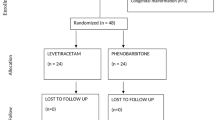Summary
Three infants with neonatal convulsions were given lidocaine infusions for three days, three weeks and three months, respectively, and the plasma concentrations of lidocaine and its metabolites were analyzed by HPLC.
After a prolonged infusion there was considerable accumulation of the metabolites.
This may account for the difficulty of stopping the infusion without relapse of the seizures.
Similar content being viewed by others
References
Bauer LA, Brown T, Gibaldi M, Hudson L, Nelson S, Raisys V, Shea JP (1982) Influence of long-term infusions on lidocaine kinetics. Clin Pharmacol Ther 31: 433–437
Blumer J, Strong JM, Atkinson AJ (1973) The convulsant potency of lidocaine and its dealkylated metabolites. J Pharmacol Exp Ther 80: 31–36
Cusack B, O'Malley K, Lavan J, Noel J, Kelly JG (1985) Protein binding and disposition of lignocaine in the elderly. Eur J Clin Pharmacol 29: 323–329
Cusson J, Nattel N, Matthews C, Talajic M, Lawand S (1985) Age-dependent lidocaine disposition in patients with acute myocardial infarction. Clin Pharmacol Ther 37: 381–386
Drayer DE, Lorenzo B, Werns S, Reidenberg MM (1983) Plasma levels, protein binding, and elimination data of lidocaine and active metabolites in cardiac patients of various ages. Clin Pharmacol Ther 34: 14–22
Eyres RL, Bishop W, Oppenheim RC, Brown TCK (1983) Plasma lignocaine concentrations following topical laryngeal application. Anesth Intensive Care 11: 23–26
Gamstorp I (1985) Pediatric neurology. Butterworths, London, pp 108–110
Giard MJ, Uden UL, Whitlock DJ, Wastson DM (1983) Seizures induced by oral viscous lidocaine. Clin Pharm 2: 110
Kuhnert BR, Knapp DR, Kuhnert PM, Prochaska AL (1979) Maternal, fetal and neonatal metabolism of lidocaine. Clin Pharmacol Ther 26: 213–220
Mihaly GW, Moore RG, Thomas J, Triggs EJ, Thomas D (1978) The pharmacokinetics and metabolism of the anilide local anaesthetics in neonates. I. Lignocaine. Eur J Clin Pharmacol 13: 143–152
Mofenson HC, Caraccio TR, Miller H, Greensher J (1983) Lidocaine toxicity from topical mucosal application. Clin Pediatr 22: 190–192
Philipson EH, Kuhnert BR, Syracuse CD (1984) Maternal, fetal, and neonatal lidocaine levels following local perineal infiltration. Am J Obstet Gynecol 149: 403–407
Rothstein P, Dornbusch J, Shaywitz BA (1982) Prolonged seizures associated with the use of viscous lidocaine. J Pediatr 101: 461–463
Strong JM, Mayfield DE, Atkinson AJ, Burris BC, Raymon F, Webster LT (1975) Pharmacological activity, metabolism, and pharmacokinetics och glycinexylidide. Clin Pharmacol Ther 17: 184–194
Author information
Authors and Affiliations
Rights and permissions
About this article
Cite this article
Wallin, A., Nergårdh, A. & Hynning, P.Å. Lidocaine treatment of neonatal convulsions, a therapeutic dilemma. Eur J Clin Pharmacol 36, 583–586 (1989). https://doi.org/10.1007/BF00637740
Received:
Accepted:
Issue Date:
DOI: https://doi.org/10.1007/BF00637740



